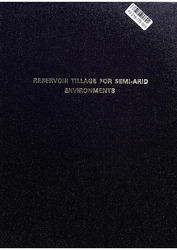| dc.description.abstract | The ever increasing world population, the decline in suitable agricultural land and food production levels require that new methods are found to increase land productivity or to bring into production land which is marginal. Reports by the Food and Agriculture Organization (FAO) indicate that there are almost 600 million hectares of potentially suitable arable land in semi-arid environments, where dry-land farming is still practised. Arable farming in these areas is hampered by low and erratic rainfall, endemic droughts and uneven distribution of land resources. In order to utilize this land optimally, a combination of agricultural technologies are required to improve its crop water storage potential and increase agricultural productivity. Studies on rain-water harvesting have shown that technologies such as reservoir tillage can provide enough moisture to grow crops, but will require adaptation for optimum seed emergence and establishment. This thesis presents the findings from a study to adapt reservoir tillage to semi- arid environments. This was done through modelling and experimentation under soil bin, rainfall simulator and glasshouse laboratory conditions. The aim was to investigate, understand and quantify water storage from this method of tillage and how it could be adapted to improve infiltration of harvested water for the benefit of field crops. A synthesis of information on infiltration characteristics, run-off and plant seed location from depressions is required in order to provide strategies and techniques for improving food production in semi-arid climates through reservoir tillage. The Aqueel (Simba International Ltd) is a commercially available, trailed tillage tool designed to form discrete depressions for water storage by compression of a soil surface under a normal load. This tool together with a soil scooping device with similar dimensions to the Aqueel designed to form depressions In shear provides a starting point for the adaptation of reservoir tillage to semi-arid environments. Experiments to characterize these two distinct depression formation methods, the evaluation of their water harvesting potential under different slopes and rainfall intensities, and the determination of optimum planting positions in relation to depression geometry were designed and conducted. The analysis and synthesis of results culminated in a conceptual modification of a typical rotary tiller to form depressions in shear. Results showed that reservoir tillage is an effective method of collecting and storing a significant proportion of rainfall. It reduces surface run-off by 54% when depressions are positioned with the long axis down-slope and by 91% if the long axis is across-slope and the depressions are staggered. Compared to depressions formed in shear (scoop), the internal soil dry bulk density of depressions formed in compression (Aqueel) was 36% more than outside thus causing significant compaction / consolidation to the soil. This compaction conserved sufficient water and did not cause any major mechanical impedance to both emergence and growth of wheat seedlings producing 5.8% more biomass accumulation than from shear formed depressions. Ballasting the Aqueel to increase penetration compromised depression wall structure, but increased depression volume by an average of 36%. Volume reduction averaged a significant 64% with increasing pre-formation soil bulk density. Depression formation in compression with a tool such as the Aqueel is adversely affected at soil bulk densities greater than 1185 kg m’3 for the sandy loam soil tested in the study, implying that this method of reservoir tillage is only suitable at low soil strength conditions. A theoretical exercise showed that it might be feasible to adapt a rotary tiller to form depressions in shear for semi- arid conditions at high soil strength conditions i.e., without the necessity of a previous soil loosening operation. | en_US |

